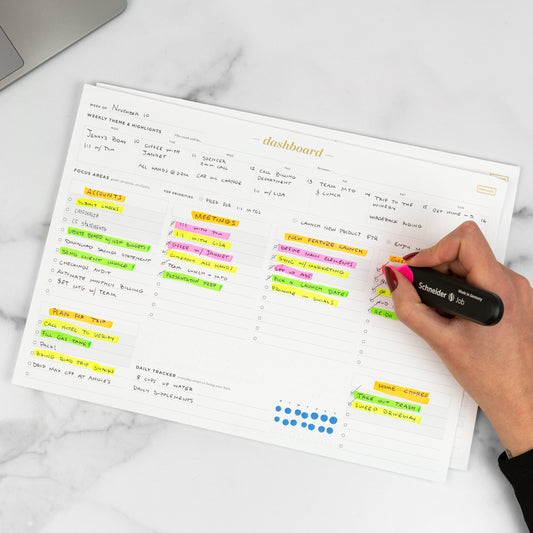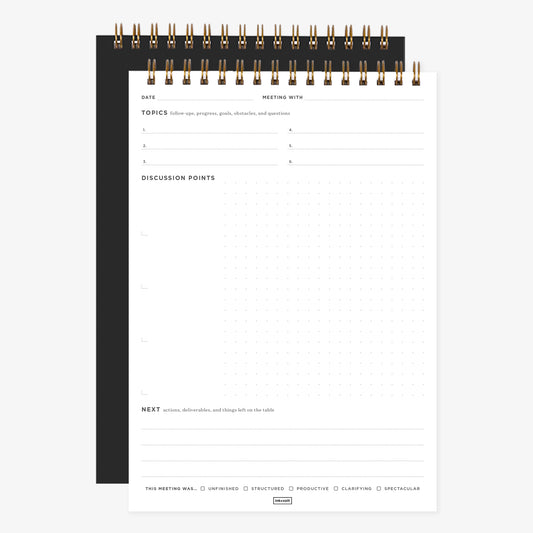Have you ever had a meeting with every single other employee at your company at the same time?
All-hands meetings typically include everyone in your company, and even companies as massive as Facebook, Etsy, and Google have them. Sometimes they are hosted ‘breakout style,’ where larger teams or departments have their own “town hall” separately from the all-hands meeting, but their purpose remains the same.
These meetings are crucial for keeping your whole team on track toward a unified company mission.
Also known as “town hall meetings,” these gatherings happen in person and virtually. Depending on the agenda, there may be a singular meeting leader who delivers the latest company highlights and developments; a selected speaker from each department may take the stage for a short time to report on their team’s activities.
Your company could have 5 employees or 5,000. Bottom line: an all-hands meeting will help foster company culture, improve team communication, boost morale, and even spark cross-departmental collaboration on some of your company’s biggest challenges.
When should you start having an all-hands meeting?
Anytime is the right time, especially if your company is growing.
Gokul Rajaram from Square says that you should start hosting an all-hands meeting as soon as your company can no longer fit in one room. Once your team has outgrown the ability to share a singular space without using their outside voices, unifying them in a meeting with a specific mission, agenda, and outcome will provide the otherwise unavailable opportunity for everyone to get up to speed on team progress towards the company mission.
How often should you host an all-hands meeting?
How often you host your company’s all-hands meetings will vary based on the intended subject matter and outcome of the meeting. Obviously, bringing together an entire organization takes a lot of time, so there needs to be a clear reason for the meeting.
Some companies host weekly “town halls,” like Google’s TGIF, who explains their structure as, “In the first 30 minutes, we review news and product launches from the past week, demo upcoming products, and celebrate wins. But the second 30 minutes is the part that matters most: Q&A.”
Other organizations hold company-wide all-hands meetings once quarterly, discussing the major changes in their financial, growth, and personnel performance.
To determine how often you should host an all-hands meeting, consider what your team needs to stay motivated, informed, and unified behind the company’s mission. This information might include:
- Departmental successes and highlights, such as completed projects, new clients, and innovative developments.
- Business improvement details such as financial reports, customer satisfaction survey results, and updates to company policies.
- Employee-focused news like promotions, new hires, changes to the org chart, new employee benefits or policies, and shout-outs for employees who have recently succeeded in their work.
If after a few meetings you discover that you need to meet more or less frequently, remaining nimble in your implementation of the meeting, but committed to the overall purpose, will ensure a successful evolution of your all-hands meeting tradition.
How do I run an all-hands meeting? Different structures work for different frequencies
How your all-hands meetings go says a lot about your company culture – and vice versa. If your company is more laid back, you may start with an informal employee interaction, like Etsy does with live employee talent performances that can be watched across the company via livestream.
If your company is more structured, you may want to start by having your CEO or Executive Director share high-level organizational goals.
Though your company culture will be a major driver behind the flow of your all-hands meeting, keep in mind what benefit you hope to bring your employees with this time. Just like any meeting, your want your attendees to feel their time was valuably spent and that this isn’t just “another meeting,” where leaders will speak and nothing will get done.
Set an agenda like you would with any other meeting, and make sure that anyone who you expect to speak has time to prepare. You want to set a hard “out” time so that everyone knows when the meeting will end; an all-hands meeting can get very long, very fast if you’re not working hard to keep things on track.
What if my team is distributed across the world?
It’s important to invite everyone – even remote employees.
Remember the purpose of the all-hands meeting: to focus, motivate, rally, and celebrate your team. Each employee in your company is showing up daily to give their time and hard work to your company. By bringing them together and sharing information transparently at a regular all-hands meeting, you’re helping them to feel more connected and valuable to the whole organization.
Ahead of time, devise your strategy to ensure all members of your company are included. This often entails implementing a broadcast software like GoToMeeting, Skype, or Join.me. Make sure people get the links to log in to the meeting well in advance, and make it clear who they should contact (like an assistant or someone in tech support) if they have trouble connecting on the day.
How to create a regularly-scheduled all-hands meeting for your company
Determine the ‘why’ of your all-hands meeting.
Before you put a date on the calendar, consider why you want to host this meeting – and why anyone should attend. The purpose of an all-hands meeting is to motivate, unify, and inform your entire company. With this thought in mind, write out exactly how that looks as you brainstorm the contents and structure of your company’s all-hands meeting.
Establish how often and for how long everyone should meet.
Consider what important information would benefit your employees on a regular basis. How often do you have news that is critical to bring everyone together for? How interconnected is your team already?
If you meet regularly with the whole team, don’t make the meeting too long. Treat it like a normal meeting — an hour is customary. If this is a more rare event, it can be longer, but remember that people can’t focus forever. Schedule in breaks and make sure there is a clear agenda with lots of structure to keep people on track.
Appoint an “owner” of the all-hands meeting and empower that person to be successful.
Organizing and executing an all-hands meeting is no easy feat. It requires the coordination of information, departmental speakers, audio/visual equipment and broadcasting software, busy schedules, remaining respectful of existing commitments, and creating a day-of experience that leaves participants feeling like they spent their time wisely.
When choosing a leader, ensure they are aware of all the necessary requirements and expectations, help them to devise a budget and a timeline, and give them some time (and possibly a team) to work out the kinks of this large endeavor. Usually the leader is an executive like the CEO, though it may make sense to have a specific department leader run the meeting if they are the expert on the topic at hand.
Set metrics and expectations for what you hope to accomplish by hosting an all-hands meeting.
Even if you know your basic ‘why,’ your all-hands meeting should come with a selection of metrics and expectations upon which you can benchmark the success of your gathering.
Some of these metrics might include: company attendance, engagement in the Q&A, the attention or lack thereof in the room, enthusiasm for future meetings, implementation of recorded next steps, and liveliness of breakout conversation when participants are given the opportunity to converse or share.
What to plan ahead of every all-hands meeting
- Set the date. Consider the future of your meeting schedule: if you pick a date and frequency now, is it sustainable for a year? Is it sustainable for three months? Set the dates for the next few meetings in advance so your company doesn’t fall off the bandwagon after the first all-hands meeting.
- Select meeting moderator, minute-taker, speakers, and key participants. The “owner” of the all-hands meeting should be empowered with the authority to organize these individuals, but having help wouldn’t be a bad investment, either. Depending on the subject-matter of the meeting, keep the room lively and interesting with a change in voices, reports from various departments, and personal touches that help each employee feel heard and understood.
- Agenda, in collaboration with each participating employee, department, and stakeholder. It can be helpful to coordinate with regional or department leads on the all-hands agenda – this way, each team can share the most important work they’re accomplishing and all of the organizational labor doesn’t rest on the shoulders of the “meeting owner.”
- Broadcast and recording method. Try a few different services out in smaller capacities before committing to a single choice the day of your event. You may find that certain services and hardware perform better, are more reliable, are easier to watch and listen to – and you’ll want to be sure you have a professional (or tech-savvy employee) at the helm.
Tips for hosting the best all-hands meeting for your company
- Understand your company culture. As your company gets more comfortable with the implementation of the all-hands meeting, your methods may evolve. But, especially in the beginning, pay respect to your company culture by selecting activities and subject matter that are relevant to the majority of your employees and their known working environment.
- Keep it short, engaging, and valuable. All-hands meetings aren’t conferences and shouldn’t last hours, especially during a busy workday! Depending on the frequency, your all-hands meeting may last 30 minutes or 2 hours, but anything longer than that will cause your audience to lose focus and dread the next “town hall.”
- Leave time for Q&A. Not every company may have the time or resources to allow for live Q&A, but the best way to help an entire company feel connected is to give them a place where their voices can be heard. Questions can be submitted ahead of time and responded to during the meeting or time can be reserved after the general information portion for live discussion and planning.
- Follow up after the meeting with important minutes and next steps. While a recorded playback of the meeting is great asset for company archives, having someone taking important meeting minutes in the moment ensures that all ideas, next steps, questions, and concerns are captured. Make sure to act on what comes up in your all-hands meeting so employees know there is commitment and follow-through from the top-down.
- Pay attention when feedback is given. Opening up the entire company to become acquainted with one another can be a scary process. Problems can arise, criticisms can take center stage during a live Q&A, and folks can become misunderstood or frustrated with company policy before you’re able to react. When feedback is provided, accept it graciously and commit to following up on the statements. This feedback is valuable to the strengthening of your company’s interconnection, and can help your all-hands meetings become a place of innovation, connection, and community.









